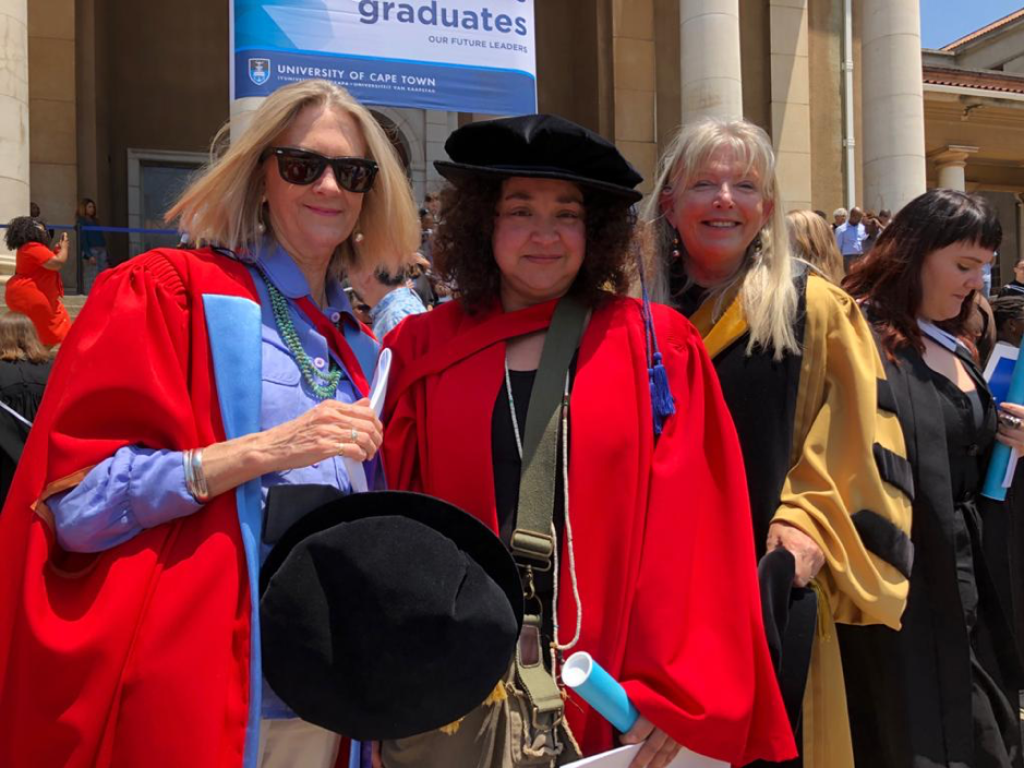Graduation of Carine Zaayman

The year finished on a wonderful note with the graduation of APC doctoral candidate, Carine Zaayman. Carine’s thesis examines the demands on archives to produce more information than they contain. These demands are seen as sites of invention and imagination in the interests of producing counter colonial narratives. In contrast, the thesis argues that paying attention to all is not there, enables us to grasp something of the significance of absence in its own right. This absence is named the “anarchive”. The archival presence of two women, Krotoa, a Goringhaicona woman who acted as interpreter between the Dutch and the Khoekhoe in the early colonial period at the Cape, and Anne, a Scottish noblewoman who lived at the Cape from 1797-1802, is examined, in the light of this anarchive. Using art visual art methodologies the thesis figures the anarchive, sharply delineating the limitations of archives and rendering implausible their ability to control our understanding of the past.
One of Carine’s examiners had this to say about the thesis:
Zaayman presents an original and compelling consideration of absence in colonial archives, arguing for the importance in confronting and dealing with these absences, while wrestling with the difficulty (even, impossibility) of doing so. Her primary concern is the “pressure” that is placed (by researchers, scholars, etc) on archives….The structure of the thesis is highly effective in that Zaayman 1) contributes important new critical analysis and understanding to the existing thinking about archives, absences, and historical silence (and she demonstrates a very sophisticated understanding of that scholarship) 2) situates the work within sociological and historical research about the colonial period in South Africa (thus expanding the meaning and relevance of the visual work into other disciplinary areas) and 3) contributes her own original and exciting analysis of the varied re-presentations, and interpretations, of Krotoa and Anne Barnard. Furthermore, Zaayman’s case studies are far from narrow. In each chapter she extends her questions and analysis well beyond the central figure to consider an impressively wide range of scholarly and visual material (hailing from South Africa and beyond), issues, themes, and images that she convincingly argues should be in conversation with each chapter’s central focus. Importantly, Zaayman breaks new scholarly ground with her focus on absence, and with her notion of the anarchive. Given the plethora of scholarly work that has already attended to questions of absence and silence in archives (in a range of academic fields). it is surprising that no scholar has, to date, considered these questions quite the way that Zaayman has. The development of her notion of the anarchive will, I believe, be quite impactful on future researchers and scholars who also grapple with the difficulty of recovering silenced stories from the past. She has effectively given us a new way of thinking about the importance of absence. I loved how she tracked her thinking about what she calls “the imprints of absence” and how she pushes the reader to consider the importance and value of “absence in its own right”. This is incredibly nuanced and impactful theoretical work (strengthened by the visual element).
Congratulations Carine!
For one of Carine’s earlier essays on the anarchive see here